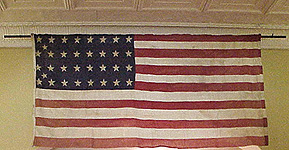| Join | Official Historian | City of Stamford | Blog | About Us | |
| Jewish Historical Society | Civil War Roundtable | Contact Us | |
|
|
|
|
The Stamford Historical Society PresentsStamford's
Civil War: At Home and in the Field
|
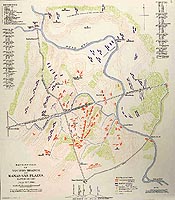 |
On July 21, Keyes Brigade was ordered to guard the Warrenton turnpike on the west of Centreville. It had reached the Stone Bridge across Bull Run at 10 AM. At 2 PM. General Tyler ordered the brigade to attack a battery on the Henry House hill near the Robinson House on its front. The Confederate battery, with 8 guns, had fired 20 to 30 rounds and was strongly posted and supported by infantry. As related in the official report of the Bull Run battle, Col. Keyes states:
At about 2 PM, Gen. Tyler ordered me to take a battery on a height in front. The battery was strongly posted and supported by infantry and riflemen, sheltered by a building, a fence and a hedge. My order to charge was obeyed with the utmost promptness. Col. James on of the 2nd Maine, and Col. Chatfield of the 3rd Connecticut pressed forward their regiments up the base of the slope about 100 yards, when I ordered them to lie down, at a point offering a small protection, and load. I then ordered them to advance again, which they did, in the face of a movable battery of 8 pieces and a large body of infantry, toward the top of the hill. As we moved forward, we came under the fire of other large bodies of the enemy, posted behind breastworks, and on reaching the top of the hill the firing became so hot that an exposure to it of 5 minutes would have annihilated my whole line.
Shortly thereafter, they were ordered to retreat, the Union artillery having failed to displace the Confederates. The Brigade retreated to Centreville and bivouacked in the same campground from which it had departed on the morning of the battle. The 3rd Connecticut Volunteers had lost 3 killed, 1 missing, 15 wounded, 14 captured and 3 wounded and captured. At 10 PM as the regiment was about the bed down for the night, orders were given to continue to retreat to Fall's Church with the rest of McDowell's routed army. During the next two days, the Brigade was busily engaged in saving equipment and stores that had been abandoned by other troops.
The 3rd Connecticut Infantry returned to Washington, D.C. and spent another three weeks there encamped before returning to Hartford. They were mustered out of service on August 12, 1861. By the war's end, 140 of the men of the 3rd had rejoined various Connecticut volunteer organizations.
The Battle of Bull Run (1st Manassas), 21 July, 1861
The scene of the first great land battle of the civil war, the stream of Bull run is located 29 miles from Washington and shielded the important rail junction at Manassas. For one hot day in July, the amateur armies both north and south clashed along its banks. Initially successful, the Union army led by Irvin McDowell was eventually driven from the field by the combined Confederate forces led by Joseph E. Johnston and P.G.T. Beauregard respectively. As part of McDowell's army, the 3rd Connecticut, a three months regiment from the state won high praise for it's valor on the battlefield, and it's composure in the subsequent Union retreat back to Centreville.
Manassas National Battlefield Park: Home Page
Connecticut 6th Regiment Volunteer Infantry
(September 13, 1861 – August 21, 1865)
1610 Recruits
56 Killed, 15 Missing, 179 Died, 379 Wounded, 11 Wounded & Captured, 99 Captured
The 6th Regiment was organized in August 1861 under the leadership of Col. John L. Chatfield of Waterbury, who had just completed his first tour of duty as the Colonel of the 3rd Connecticut Infantry which had fought at Bull Run. Company D was organized in Stamford. The 6th encamped at Oyster Point, New Haven and was mustered into State service September 3, 1861, and into United States service September 12th.
On September 17, the regiment, numbering 1,108 officers and men, left New Haven for Washington, D.C., arriving on the 19th where it encamped on Meridian Hill. It was brigaded with the 7th Connecticut, 9th Maine, and 3rd and 4th New Hampshire Vols., to form the 3rd Brigade of Sherman's Expeditionary Corps. The brigade was under the command of Brig.-Gen. Horatio G. Wright, from Orange and Clinton, afterwards commander of the 6th Army Corps.
After 20 days of drill and discipline, broken only by a visit from Abraham Lincoln on a tour of inspection, the regiment left Washington for Annapolis, Md on October 8. There, it joined forces being organized under Brig. Gen. Thomas W. Sherman, of the Army, and Admiral Samuel F. Dupont, of the Navy, for an expedition to the South Carolina coast. The force numbered over 12,000 soldiers. On October 19, the expedition set sail, encountering a terrible storm off Cape Hatteras, North Carolina which disabled and wrecked a number of the vessels. The fleet arrived off Port Royal, South Carolina on November 4, 1861.
The bombardment of Forts Walker and Beauregard began on November 7. The battle between the Union and Confederate naval forces was the first naval engagement of the war and took place in full view of the regiment, which was in the advance to land as soon as the forts were reduced. The engagement lasted 5 hours and at its close, the 6th and 7th Connecticut regiments landed in small boats and took possession of the forts. The subsequent months were spent rebuilding the forts and raiding the surrounding countryside for supplies.
In January 1862, the regiment took part in a failed expedition to capture Savannah, Georgia by way of Warsaw Sound. The 6th was kept on board a small, overcrowded boat for 16 days without cooked food or any vegetables. The hard tack was full of vermin and the water supply was stored in empty kerosene barrels. There was insufficient room on board for all the men to lie down at once. Spotted fever soon broke out and many died unnecessarily.
In March 1862, the 6th was engaged in the Union victory at the siege of Fort Pulaski, on the Savannah River, Georgia. The regiment participated in the construction and maintenance of a battery on Jones Island, located between the fort and the city of Savannah. The battery's function was to prevent the reinforcement of Fort Pulaski while preventing the Confederate ironclad Atlanta from passing down river. Because James Island was completely submerged at high tide, the work was difficult and dangerous and many men suffered from disease. On April 11, 1862, Fort Pulaski surrendered and the 6th moved to better quarters on Dawfuski Island
The 6th next took part in a second expedition against Charleston, South Carolina in June. They marched over Jones Island and for three days lacked food because their wagon trains were cut off. After suffering many hardships, they arrived at James Island June 10, and on the 12th were engaged in a skirmish that left 3 men wounded. The 6th took part in the Union loss at the Battle of Secessionville, S.C. on June 16. After the battle, the 6th went into camp at Beaufort, S.C. and performed picket and guard duty until October 22, 1862 when they were engaged in the Union defeat at the Battle of Pocotaligo. The regiment suffered its first casualties with 5 killed and 30 wounded. Severely wounded were Col. Chatfield and Lt. Col. John Spiedel who had been commanding the regiment. The 6th returned to Beaufort, then was transferred to Jacksonville, Florida on March 18, 1863 where they participated in the fortification and defense of the town.
On April 1, 1863, the 6th left Jacksonville and traveled through Hilton Head and Beaufort along the coast to Folly Island arriving May 1. There they participated in the second attack of Charleston and Fort Sumter by way of Morris Island The men spent three weeks constructing fortifications at night without being discovered. The brigade built 10 batteries and mounted 48 heavy siege guns, within 400 yds. of the enemy's works on Morris Island At midnight on July 9, the regiment advanced up the Folly River in boats with Strong's Brigade and at daybreak, under intense fire, landed on Morris Island They charged and took the fortifications, capturing 125 prisoners and two battle flags. The 6th had one man killed and 11 wounded.
On July 18, Strong's Brigade led the charge on the sea face of Fort Wagner. Col. Chatfield, who had resigned from command of the brigade to lead his regiment, was mortally wounded. The 6th, virtually without aid, held an angle of the fort for three hours. It was forced to retreat after a number of men were captured. The 6th took about 400 men into the battle and its losses were 16 killed, 9 missing, 83 wounded, 23 captured and 6 wounded and captured, roughly 35% of the regiment. The loss to the regiment was so great that it was sent to Hilton Head to recuperate. Col. Chatfield died there of his wounds and Lt. Colonel Speidel was transferred to the Invalid Corps because of his wounds. Throughout the fall and winter of 1863 many of the men re-enlisted and the regiment was engaged in routine duty.
In April of 1864, the regiment, by then part of the 10th Army Corps, 1st Division, 2nd Brigade, was transferred to Virginia to take part in the campaign under Maj. Gen. Benjamin Butler and the Army of the James. On May 9th and 10th, the 6th was engaged at the action at Chester Station on Petersburg Road. Later, on May 16th, it was engaged at the Battle of Drewry's Bluff on Proctor's Creek. The following day and again on June 2nd it was involved in skirmishes at Bermuda Hundred. In the midst of this activity Alfred P. Rockwell, formerly Captain of the 1st Connecticut Light Battery, was promoted Colonel.
On June 9, 1864, the 6th took part in the attack on Petersburg under Maj. Gen. Q. A. Gilmore. A week later, the 6th advanced from Bermuda Hundred and tore up some of the track of the Petersburg railroad. It came under fire from the Confederate army en route to Petersburg to defend the city against Gen. Grant. The regiment lost 184 men in theses engagements from May 10 to June 18, 1864. On June 25, the 6th crossed the James River and covered the movement of Maj. Gen. Sheridan who was returning from his cavalry raid on Richmond. From June 25 to August 13, the 6th remained in the earthworks at Bermuda Hundred guarding the Union line.
On August 14, the 6th left the trenches, crossed the James and proceeded to Deep Bottom and Deep Run where they were engaged in the Battle of Strawberry Plains on August 16. They captured two lines of earthworks, 200 prisoners and two stands of colors. Five men were killed, 69 wounded and 11 missing. The 6th was then ordered to Petersburg and took part in the city's siege on the front line until September 27. During this time, the 6th was on picket duty and built Fort Haskell, one of the largest and strongest forts on the Union line. The men slept in holes in the ground and rarely ate cooked food. The difficulties at Petersburg were more dangerous than a pitched battle as the men were under fire continuously day and night. Those who chose not to reenlist when their three-year term expired on September 11th were discharged at Petersburg and returned to New Haven with full honors.
On September 28 the 6th marched to the north side of the James River near Richmond, VA and was engaged in the Battle of Fort Harrison, New Market Road and Chaffin's Farm. They advanced up the Darbytown Road to within 3 miles of Richmond.
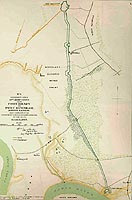 |
On October 1, the 6th again engaged in skirmishes on Darbytown road at Laurel Hill Church. Six days later the Confederates attacked the Union forces on the New Market Road. The brunt of the fighting fell upon the 1st Division (Ames) of the 10th Army Corps that included the 6th Connecticut. The Union repelled the attacks. On October 13 the 6th was again engaged on the Darbytown Road and on October 27 on the Charles City Road.
Prior to the presidential election of Nov. 1864, the 6th with other regiments was ordered to New York in anticipation of riots. The forces were housed on boats along both the East and North Rivers. The men were not permitted visitors and after the elections, immediately returned by boat to the Petersburg front. They remained on picket duty until late December 1864 when they took part in the second attack on Fort Fisher. The regiment accompanied Maj. Gen. Alfred Terry's 10th Corps on the expedition to North Carolina and witnessed the fort's bombardment. On January 16, 1865 the fort was taken.
Subsequently, the 6th took part in the operation to capture Wilmington that opened a base for Maj. Gen. William T. Sherman in North Carolina. It was involved in a skirmish on January 19 near Fort Fisher, the capture of Wilmington on February 21, and a skirmish on the Northeast Branch of the Cape Fear River on February 22. The 6th ultimately performed garrison duty along the line of the Wilmington & Weldon Railroad from Wilmington to Goldsboro until August 1865. The regiment was ordered back to New Haven, July 28, and mustered out of US service August 21, 1865. Of its original member, 205 reenlisted and 600 recruits were credited to the regiment.
BATTERY WAGNER, S.C., 10 July-Sept. 1863
Locate 1.5 miles below Fort Sumter, and defended by 1,200 troops, Battery Wagner was a formidable obstacle for a Union attempt to seize Charleston. On July 10, Union Maj. Gen. Quincy Gillmore planned a quick strike in an effort to take the fort, but failed. On July 18, he tried again with a more formidable force. For three hours, the Sixth Connecticut held an angle of the fort. Left unsupported, the regiment was forced to retire leaving 35% of its number on the field of battle, including Col. Chatfield who received his death wound. One southern writer called the Sixth – the bravest of the brave. This is the fort of the movie GLORY and the black troops of the 54 Massachusetts.
FORT HARRISON (Chaffin’s Farm) 29-30 September, 1864
Located southeast of Richmond and protecting camps, bridges and batteries along the James River, Fort Harrison was a vital linchpin in the defenses of the Confederate Capitol. On the 29th of September it became the focal point of a determined Federal attack By Major General E.O.C. Ord. As part of the Union command, the 6th Connecticut and 29th Connecticut (colored troops) were heavily engaged and brought the Union Army within site of the spires of Richmond.
Fort
Pulaski National Monument
The Capture of Fort Pulaski
Battle of Secessionville
Drewry's Bluff
Battery Wagner
Fort Harrison
Connecticut 10th Regiment Volunteer Infantry
(September 30, 1861 – September 5, 1865)
1820 Recruits
71 Killed, 7 Missing, 199 Died, 441 Wounded, 8 Wounded & Captured, 32
Captured
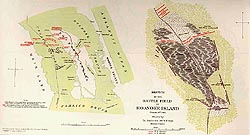 |
The 10th Regiment was organized in the summer 1861 and mustered into U.S. service September 30th at Camp Buckingham, Hartford, Connecticut. On October 31, it left for Annapolis on the steamers Granite State and Mary Burton. The 10th was under the command of Col. Charles L. Russel of Derby and was assigned to the First Brigade of Burnside's Division. On January 2, 1862, the 10th took transports with the Burnside Expedition to North Carolina. The regiments endured poor conditions on board ships until landing at Roanoke Island on February 7. The following day they participated in the Union victory over the Confederate fortifications at Roanoke. Four were killed, including Col. Russell and 51 were wounded. Col. Albert Drake took over the 10th.
On February 11, the 10th re-embarked, landing finally at Slocum's Creek on March 13. The next morning, after a hard march, they fought in the Battle of New Bern. Casualties numbered 5 killed, 20 wounded. Col. Drake succumbed to disease and was succeeded by Maj. Ira Pettibone. The 10th remained all summer in North Carolina, taking part in a number of minor engagements. On July 22, all Union troops in North Carolina were organized into the 9th Corps under Major-General Burnside.
In November, Maj. Robert Leggett ultimately took command of the 10th. During the subsequent Goldsboro campaign, the 10th took part in a major battle at Kingston. Some 6,000 Confederate troops defended the town with an additional brigade posted across the Neuse River to defend the bridge. The 10th charged the Confederates and took the bridge despite ongoing cannon fire. They drove the Confederates from their position and ultimately captured 500 prisoners, some small arms and 11 pieces of artillery. The 10th suffered 15 killed and 88 wounded, the greatest loss in a single day of the 10th 's campaign. On December 16, the 10th participated in subsequent campaigns at Whitehall and Goldsboro with no loss. On December 24 all troops in North Carolina were made into the 18th Army Corps with Maj. Gen. J.G. Foster in command.
On January 29, 1863, the 10th, under Gen. Foster, went to South Carolina to attack Morris Island and Charleston. This offensive was not realized, however, and the 10th was subsequently joined to Brig. Gen. Orris S. Ferry's Division of the 10th Corps. On April 9, 1863, the brigade left St. Helena Island for Edisto Inlet and on the 10th the regiment took Seabrook Island After a brief engagement with Confederate troops on neighboring Johns Island, the 10th boarded boats bound for James Island landing there on the 16th. It was assigned to Maj. Gen Alfred Terry's Division, 10th Corps.
 |
On the 17th, after a standoff with Confederates on James Island, the 10th marched to Coles Island opposite Ferry Is and boarded boats for Morris Island There, they joined the third column of attack on Fort Wagner. A truce was made just prior to the attack however. The 10th remained on duty outside Fort Wagner suffering debilitating conditions. By the time the 10th left for St Augustine, following Fort Wagner's capture, 60% of the men were on the sick list.
After a brief posting in St. Augustine, Florida, on April 18, 1864 the 10th took transports to Virginia, reported at Gloucester Pt. the 25th and was assigned to the 3rd Brigade, Terry's 1st Division of the 10th Corps Army of the James. On May 7 the regiment took part in the battle at Port Walthall Junction that drove the Confederates away from the railroad. From May 13-16 the regiment fought in the Battle of Drewry's Bluff. The main battle took place on May 16. During the course of the fighting the 10th was ordered a number of times to hold positions against the Confederate forces while Union troops withdrew. The regiment then became the rear guard to Bermuda Hundred. The regiment lost 36 men in these movements.
On June 15, 1864 the regiment participated in repelling the attack of Confederate Gen. P.TG. Beauregard on the Bermuda Hundred. The main body of the 10th advanced so rapidly that they captured Confederate Howlett House Battery.
On the evening of June 20 the 10th Corps under Alfred Terry moved down to Jone's Landing on the James River with orders to cross the river and capture Deep Bottom only 9 miles from Richmond. Delay led the General to order the 10th Connecticut along with the 11th Maine across by boat and they captured the Confederate position. From this time until the end of the war Deep Bottom was the base of operations against Richmond. On July 26 the 10th Connecticut and 11th Maine were ordered to cross from Deep Bottom to Strawberry Plains and retake a position from which a brigade of the 19th Corps had been driven. The two regiments successfully retook the position. The following morning the two regiments joined with a brigade of the 2nd Corps and took the Confederate works suffering nine casualties.
On September 30, 1864 the three-year term of the regiment expired. Losses in battle, by disease and the mustering out of the non re-enlisted men had reduced the command to a little more than 100 men present for duty. On October 7, the 10th was attacked by a Confederate brigade but held its ground through two assaults. The losses to the 10th were 8 killed or wounded. On October 13, the 10th with only 90 men in its ranks was ordered to join Pond's Brigade in charging a well manned line of Confederate earthworks on the Darbytown Road five miles from Richmond. The outnumbered 10th was repulsed with 5 killed, 1 missing, 38 wounded and 5 captured. Another 5 were wounded in a skirmish on October 27 near the Gerhardt plantation.
Following a brief sojourn to New York City to keep order during the elections, during which time they never disembarked, the 10th returned to Virginia and in November and December was replenished with 800 recruits. The regiment marched to the left of the Union line at Petersburg on March 28, 1865. It engaged the enemy at Hatcher's Run on April 1. The following day six companies of the 10th took part in the assault on Fort Gregg a key to the inner defenses of Petersburg. The 10th Connecticut charged and carried the southern angle of the works. The State flag, with 23 bullet holes through it and three through the staff was the first banner planted on the parapet. Out of 13 officers and 180 men engaged, the 10th suffered 8 officers and 71 men as casualties. The 10th and the rest of the Army of the James then moved quickly to block Confederate escape near Appomattox Court House. The Confederates were shortly surrounded and flags of truce ended the fighting.
After the surrender by Gen. Lee on April 15, 1865, the 10th Connecticut moved to Richmond staying there till August 25th when they were ordered home. They mustered out September 5, 1865.
ROANOKE ISLAND, N.C., 8 February, 1862
A choke point in Croatan Sound, whoever controlled Roanoke Island, controlled access to Albemarle Sound, and the North Carolina low country. In a Civil War rarity, supported by 100 ships, General Ambrose Burnside landed a force of 15, 000 men, a huge amphibious attack for that time, and successfully seized control of the island. The 10th Connecticut played a conspicuous part in the battle as part of the attack on the rebel three gun battery which controlled the main road. Col. Charles Russell of the 10th was killed in the attack.
The Civil War on Roanoke Island
Connecticut 13th Regiment Volunteer Infantry
(February 18, 1862 – April 25, 1866)
1480 Recruits
38 Killed, 157 Died, 179 Wounded, 1 Wounded & Captured, 58 Captured
The 13th Connecticut Infantry was organized in Fall 1861. They were based at Durham & Booth's Carriage Factory, Chapel St. New Haven on November 25, 1861. The 13th wintered in barracks in New Haven. Henry W. Birge was appointed Colonel. He had served earlier as Major of the 1st Connecticut Heavy Artillery. Small pox broke out in the barracks during the winter killing 12 men.
On March 17, 1862, the 13th left New Haven for New York City, 1000 soldiers strong. On the 18th, they boarded the City of New York in New York harbor. The 13th was assigned to Maj. Gen. Benjamin Butler's expedition to capture New Orleans. Contrary winds delayed the departure to March 23 and, ultimately, the 13th arrived and disembarked at Ship Island, Mississippi April 13. The 13th left Ship Island May 4 and arrived at New Orleans on May 12. They were housed in the Custom House and assigned to provost duty. Col. Birge was given the command of the defenses of New Orleans. The 13th spent the summer of 1862 in the city with occasional raids up river.
On September 29, a brigade was formed known as the Reserve Brigade consisting of the 12th and 13th Connecticut and additional regiments from Louisianna, New York, and New Hampshire. The brigade was formed at Camp Kearney in Carrollton and Brig. Gen. Godfrey Weitzel was put in command. On October 24 the brigade traveled up the Mississippi landing at Donaldsville the next day. Its mission was to break up the Confederate force under Richard Taylor. On October 27 the Battle of Georgia Landing or Labadieville was fought and the Confederates were scattered. The 13th lost 1 killed, 3 wounded. It reached Thibodeux the following day and formed Camp Stevens on the 30th. The 13th broke camp on December 27, 1862, and reached Baton Rouge on December 31. They went into camp on the Arsenal grounds on Jan. 1, 1863.
On March 13, the 13th moved with Maj. Gen. Nathaniel Banks' army to the rear of Port Hudson and made a feint to assist Adm. Farragut's run past the fort. The next morning the 13th withdrew to Baton Rouge and on March 28, left that city for the 1st Red River Campaign to take Western Louisiana from the Confederates. Col Birge commanded the brigade and Lt. Col. Alexander Warner led the 13th. On April 13, the 13th fought a skirmish at Sand Beach and, on April 14th, in the Union victory at Irish Bend. The 13th lost 8 killed and 42 wounded. On April 20, the 13 camped at Washington, LA and from April 30 to May 5 were at Barre's Landing. On May 11, they reached Stafford's Plantation and were 13 miles from Alexandria, LA. They then returned to the rear of Port Hudson and took part in its siege from May 24 to July 9, 1863. The 13th participated in the assaults of May 27 and June 14.
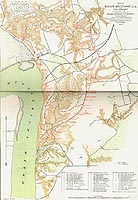 |
After the disastrous assault of June 14, Gen. Banks called for a column of 1000 men to storm Port Hudson. However, the storming of Port Hudson proved unnecessary after the capture of Vicksburg by Gen. Grant. On July 8 Port Hudson surrendered. On July 13, the 13th took part in the final skirmish against Gen Richard Taylor's forces at Donaldsville. The 12th and 13th Connecticut then traveled to Brashear City, arriving on July 25 where they remained on outpost duty until August 19 when they returned to camp at Carrollton and went into tents for the first time in 5 months. On August 30, the regiment went into camp at Thibodeaux on the Bayou La Fourche.
Early in January 1864, Joseph Selden arrived as recruiting officer. He recruited 400 of the 406 men present for duty at that time to re-enlist for 3 years. On March 19, 1864, the 13th started on the 2nd Red River Campaign. On March 28, the 13th reached Alexandria where they were put on garrison duty. On April 20, the 13th moved in the advance toward Cane River Crossing but halted because of a Confederate battery. While scouting the situation Union Brig. Gen Henry Birge, his staff, and a detachment from the 13th were ambushed (18 out of 30 were killed or wounded). The rest of the 13th charged the battery and the Confederates fled. The loss to the 13th was 2 killed and 22 wounded. The 13th returned to Alexandria on the 29th and was stationed as an outpost at Pineville, remaining there until a dam was completed. The regiment then left for Morganzia near the junction of the Mississippi and Red Rivers, arriving on May 21and remained there till July 2, when it traveled to New Orleans and then for home on a veteran furlough of 30 days. The 13th arrived in New Haven July 27, 1864.
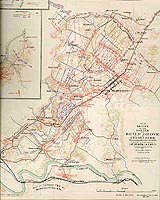 |
In August, the 13th was joined to the 19th Army Corps, 2nd Division, 2nd Brigade under Gen. Philip Sheridan for the 1864 Shenandoah Valley Campaign. The 13th participated in the Union victory at the Battle of Opequan on September 19, 1864. Their losses were 6 killed and 41 wounded, 1 wounded and captured and 29 captured. It was the greatest loss for the 13th in a single day. The 13th then fought in the battle and victory at Fisher's Hill on Sept. 21. On October 19, the 13th fought in the Union victory at the Battle of Cedar Creek. The 13th lost 2 killed, 20 wounded and 9 captured. The regiment then went into barracks at Camp Russell near Winchester where they remained until December 1 when they were sent to Martinsburg, West Virginia. On the 15th, 125 men who had chosen not to reenlist were discharged and the remainder became known as the Veteran Battalion of the 13th Connecticut volunteers.
In January 1865 the 13th was sent to Savannah and remained until March 12th when it was sent to New Bern, North Carolina. There, they performed provost duty until the end of the war.
PORT HUDSON, LA., 14 March-8 July 1863
Located 25 miles north of Baton Rouge and 110 miles from Vicksburg, Port Hudson was an important Confederate bastion on the Mississippi River. Early on, it became an important target for Federal land and naval forces as they tried to seize the river and split the Confederacy in two. As Part of Nathaniel P. Banks Army of the Gulf, the 13th and 28th Connecticut regiments displayed considerable valor in the attacks and siege of Port Hudson.
Port Hudson State Historic Site
CEDAR CREEK, VA., 19 October, 1864
After the Union victories at Winchester, Fisher’s Hill and Tom’s Brook, Confederate General Jubal Early’s force seemed to no longer be a threat in the Shenandoah Valley. It was hardly the case as, early on the morning of the 19th , the Confederates surprise attacked a resting Union Army encamped south of Middletown. Initially successful, the rebel attack was eventually rolled back because of stiff resistance late in the day from units like the 13th Connecticut of the 19th Corps. Early’s army then fled southward.
Cedar Creek Battlefield Foundation
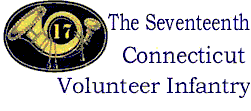 Connecticut 17th Regiment Volunteer Infantry
Connecticut 17th Regiment Volunteer Infantry
(August 28, 1862 – July 19, 1865)
1,167 Recruits
28 Killed, 9 Missing, 100 Died, 127 Wounded, 32 Wounded & Captured, 218
Captured
The 17th Connecticut was almost entirely made up of Fairfield County men. Company B was comprised mostly of Stamford men (67). This company was led by Maj. Allen Brady and Charles Hobbie (originally of Darien) and Marcus Waterbury served as 1st Lt. The 17th was under the command of Col William H. Noble of Bridgeport. The regiment gathered at Camp Aiken in what is now Seaside Park, Bridgeport, and was mustered into United States service on August, 28 1862. The 17th left by rail for New York City on September 3.
Upon their arrival in Baltimore, they found the city alarmed by raids by Confederate cavalry and the regiment was detained for a couple of days by Maj. Gen John E. Wool, commander of Baltimore's defenses. On October 15, 1862, the regiment continued by rail to Washington, D.C. Upon arrival, they were posted to Fort Kearney. On November 5, 1862, the 17th was finally ordered to join Second Brigade (McLean) of the First Division (Stahel) of the 11th Corps of the Army of the Potomac under General Franz Sigel at Gainesville, Va. where his troops were holding Thoroughfare Gap in the Bull Run Mountains. The other units comprising the 2nd Brigade were the 25th, 55th, 75th and 107th Ohio. These five regiments served together for the rest of the war in Virginia, South Carolina, and Florida.
The 17th was stationed first at Hopewell Gap, then Chantilly before marching off December 6th to Fredericksburg. The corps was held at Brooke Station as a reserve to the advance of Maj. Gen. Burnside's Army of the Potomac. After the disaster at Fredericksburg, the 17th spent the winter in camps at Stafford Court House, Belle Plain, and Brooke's Station, Va.
At the end of April 1863, the 11th Corps, now under Maj. Gen. Oliver Otis Howard, was ordered to the area near Chancellorsville. On the field of Chancellorsville, the 17th was stationed near the extreme right of the line. Two of its companies were on picket in the Wilderness when Stonewall Jackson surprised and routed the 11th Corps on May 2. This was the first engagement faced by the 17th. Col Noble was wounded in the attack and Lt. Col. Charles Walter was killed. A total of 106 casualties were lost in the battle.
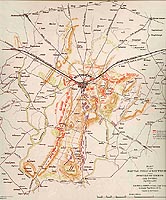 |
After the withdrawal of Gen. Hooker from this battlefield, the 11th Corps rested near Brooke's Station until the Army of the Potomac began following Lee's advance north which ultimately led to the Battle of Gettysburg. The 17th reached the battlefield at the height of the action on July 1, 1863. They were posted to the extreme right of the Union line. An overwhelming force under Confederate Gen. John B. Gordon struck the regiment at Oak Hill, now known as Barlow's Knoll. It was here that the regiment lost most of its 26 killed. Overwhelmed and repulsed by the superior Confederate force, the 11th corps retreated to Cemetery Hill. The 17th Connecticut was posted on its eastern foot, a spot they held for the next two days. The total number of casualties for the regiment was 206. Lt. Col. Douglas Fowler was killed and Maj. Allen Brady was severely wounded. Following the battle, the Union army began pursuing the escaping Confederates on July 6, 1863. The Confederates succeeding in escaping before a further attack could be made.
In early August, at Catlett's Station, Va., the division was ordered to take rail for Alexandria and there to embark by ship for South Carolina. The regiment reached Folly Island, SC on August 12. Their brigade, under Brig. Gen Adelbert Ames, was soon transferred to Morris Island, SC. At that time, Confederate shells and round shot was reaching nearly the whole island. There the regiment witnessed the first gun fired in Union Maj. Gen Quincy Gillmore's bombardment of Fort Sumter. The regiment was in the siege works approaching Fort Wagner for several days. For the next two weeks, the regiment was under constant fire from Fts. Wagner, Moultrie, Johnson and from the batteries near Charleston. The 17th then joined with the 6th and 7th Connecticut in Brig. Gen Alfred Terry's Division. Terry, second in command to Gilmore, planned to assault Fort Wagner but the Confederates surrendered the Fort on September 6th just before the attack.
Following Fort Wagner's surrender, the 17th remained camped on Folly Island. Expeditions were made against John's and James Island from February 6-14, 1864. On February 22, they were ordered to embark for Florida. The Union defeat at the Battle of Olustee left the Union position in Florida compromised. Upon their arrival in Jacksonville, Col Noble assumed command of the 2nd Brigade. After about a month without incident, the Union force at Jacksonville was broken up and while most of the regiments returned north, the 17th Connecticut was sent to St. Augustine to relieve the 10th Connecticut while the Ohio regiments remained at Jacksonville. The 17th remained headquartered at St. Augustine until the war's end; one company stationed at Fort Marion, while the rest were raiding or scattered at outposts.
On April 25, 1864, Col. Noble started on a foraging raid with a large part of his brigade, including the 17th to Volusia, 75 miles up the St. John's River. On April 28 they captured large amounts of cotton and 1,000 head of cattle. They returned to St. Augustine three days later but left troops to hold posts at Welaka and Saunders. On May 19, Company B, primarily made up of Stamford men, was captured at Welaka. The force of 40 men and two officers were taken to Andersonville prison. Two other companies posted at Volusia held out until relieved. The regiment participated in various raids throughout this time. Noble was captured on December 24, 1864, and spent the rest of the war at Andersonville Prison.
On February 4, 1865, Lt. Col. Wilcoxson, then in command of the 17th, was mortally wounded and his adjutant killed at Dunn's Lake, FL while on an expedition to Braddock' s Farm some 50 miles from St. Augustine. Thirty men were also captured and taken to Andersonville. The 17th served without incident for the remainder of the winter and spring of 1864-5. In June, the 17th was ordered to Jacksonville and thence to Hilton Head, SC where they were mustered out July 19, 1865. They arrived in New Haven Connecticut August 3.
Private Wm.
H. Lockwood |
Connecticut 28th Regiment Volunteers
(November 15, 1862 – August 28, 1863)
678 Recruits – 188 from Stamford
10 Killed, 96 Died, 51 Wounded, 1 Wounded & Captured, 6 Captured
The 28th was the last Connecticut regiment organized under the call for 9-month volunteers. It was composed of only 8 companies: five from Fairfield County and 3 from Litchfield County. Stamford men in the regiment numbered 188. All of the field and line officers were elected. Samuel P. Ferris (West Point '61) of Stamford, was commissioned Colonel and held the office during the entire service of the regiment. He had entered the service as a 1st Lieutenant in the 8th US Infantry. Wheelock T. Batcheller of Winchester was elected Lt. Colonel. He had been a 1st Lt. in the 2nd Connecticut Infantry. William B. Wiscomer of Greenwich was elected Major.
The 28th Infantry began gathering on September 15, 1862 at Camp Terry in New Haven and was in tents and barracks for about two months. On November 15, the 28th was mustered into the service and three days later left New Haven by boat headed for New York City. November 19, the regiment went into camp at Centerville, Long Island. The 28th was camped with the 23rd, 24th, 25th, and 26th Connecticut regiments. On November 29, six companies of the regiment boarded the steamer Che Kiang with a group from the 23rd regiment under the command of Col. Charles Holmes of Waterbury. The two 28th regiment companies not on board joined the regiment later after a difficult passage by steamer.
The Che Kiang sailed from New York December 3, 1862 and after a very difficult voyage, weathering a terrible storm off Cape Hatteras, North Carolina, the ship reached Ship Island, Mississippi December 12. After the men recovered from seasickness they boarded the steamer again, leaving Ship Island December 17, 1862.
On December 19, they landed at Camp Parapet, Carrollton, Louisiana just north of New Orleans. After a short stay, on the 22nd the regiment again boarded ships and sailed for Pensacola, Florida, arriving on the 29th.
The 28th Connecticut was posted at Pensacola for a number of months and had a pleasant stay. They were quartered in houses abandoned by the owners when the Confederates evacuated. Drill and guard duties occupied the troops for much of the time. Occasionally, the men led expeditions into the interior and along the coast and now and then steamers arrived with the mail.
The 28th regiment left Pensacola March 20, 1863 moving into tents at Barrancas. Camp duties continued as at Pensacola with occasional expeditions to break up the monotony. On May 10, the 28th left Barrancas and traveled by steamer to Brashear City, Louisiana, arriving on the 12th. They left Brashear City on the 23rd and arrived at Springfield Landing on the 25th then proceeded immediately to Port Hudson, Louisiana, arriving the next day.
 |
While at Port Hudson, the 28th with the 1st Brigade (Ingraham/Ferris), 3rd Division (Paine), 19th Corps was under continual fire in the trenches. They assisted in all siege operations and in the trenches. The engagement lasted from 27th May until July 9, 1863. In the assault on June 14 the regiment furnished 100 of the 250 men for the storming party on the bulwarks. Eight men were killed, 43 wounded, 5 captured and 1 wounded and captured during this action. The 28th suffered severely. Lt Charles Durand of Stamford was shot almost as soon as the order to charge was given. Also Corp. James Vail and Jason Wardwell, both of Stamford, lost their lives in the tragic assault. A number of other Stamford men would ultimately succumb to wounds received in the engagement including: George W. Hartson, Seth H. Hoyt, Thomas W. Moller, Charles Rosborough and Corp. William Webb. At the surrender of Port Hudson on July 9, the 28th moved inside the fortifications and remained there until departing for home August 7, 1863. Several troops died on the return trip having been weakened by the diseases prevalent about Port Hudson. The 28th traveled home by way of the Mississippi River to Cairo, Illinois and then by rail to New Haven. The men were mustered out of service at New Haven on August 28, 1863. Of 188 men 42 lost their lives either during or as a result of having served.
Principal Engagements:
Siege of Port Hudson, La., May 27 to July
9, 1863
Port Hudson, La., June 14, 1863
PORT HUDSON, LA., 14 March-8 July 1863
Located 25 miles north of Baton Rouge and 110 miles from Vicksburg, Port Hudson was an important Confederate bastion on the Mississippi River. Early on, it became an important target for Federal land and naval forces as they tried to seize the river and split the Confederacy in two. As Part of Nathaniel P. Banks Army of the Gulf, the 13th and 28th Connecticut regiments displayed considerable valor in the attacks and siege of Port Hudson.
Port Hudson State Historic Site
Connecticut 29th (Colored)
Regiment Volunteer Infantry
(August 1863 – October 24, 1865)
1,249 Recruits – 21 from Stamford
29 Killed, 199 Died, 159 Wounded, 1 Captured
The Twenty-ninth was the first of two black regiments organized in the state of Connecticut. Initially, enlisted in August of 1863, the regiment was not furnished with Springfield Rifles until April of 1864. It's colonel was William B. Wooster, formerly Lt. Col. of the Twentieth.
At first assigned to the Ninth Corps at Hilton Head, South Carolina, after training for four months, it was transferred to Bermuda Hundred, Virginia, the scene of thick action on the Richmond-Petersburg front. Here would be the scene of all their combat and service.
 |
From August until April of 1865, the regiment was actively engaged as part of William G. Birney's Brigade of David B. Birney's Division of the Tenth Corps. On Sept. 28th, it was involved in the successful Union assault against Fort Harrison. The next day, the Confederates counter- attacked, but the 29th with other black regiments fought bravely and repelled it. Also, the following month, on October 21 and 28th, at a place called Ken House, the men of the regiment formed the skirmish line for the division and suffered loss.
Early in March of 1865, after months of picket duty, drilling, and building forts and roads, The 29th was placed back into Fort Harrison. From there it watched the demise and final capitulation of the Confederate capital. On April 3rd, the men of the 29th witnessed the explosions of rebel gunboats on the James, the destruction of magazines in Fort Darling, the arrival of rebel deserters and the last gasps of a dying Confederacy. The men were soon over and through the breastworks and pushed on towards Richmond. Companies C and G of the regiment claimed to be the first infantry on their front to reach the now burning Richmond. Until the 13th, it remained in the defenses of that now conquered city.
After time guarding Confederate prisoners of war at Point Lookout, Maryland, the 29th was shipped to Texas as part of the forces of occupation. It ended it's service at Brownsville, Texas. After passing through New Orleans on the way home, the regiment arrived back in Hartford on November 24th and was paid and discharged having done their duty quite well.
Engagements:
Petersburg, Va., Aug 12 to
Sept. 24, 1864
Chaffin's Farm, Va., Sept. 29, 1864
Richmond, Va., Sept. 29 to Oct 1, 1864
Darbytown Road, Va., Oct 13, 1864
Kell House, Va., Oct. 27 and 28,1864
FORT HARRISON (Chaffin’s Farm), 29-30 September, 1864
Located southeast of Richmond and protecting camps, bridges and batteries along the James River, Fort Harrison was a vital linchpin in the defenses of the Confederate Capitol. On the 29th of September it became the focal point of a determined Federal attack By Major General E.O.C. Ord. As part of the Union command, the 6th Connecticut and 29th Connecticut (colored troops) were heavily engaged and brought the Union Army within site of the spires of Richmond.
Citizens of Color, 1863-1890: Military and Political Participation, from: A Struggle from the Start, The Hartford Black History Project.
